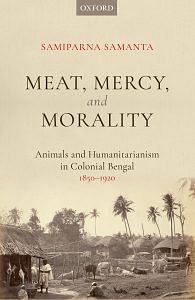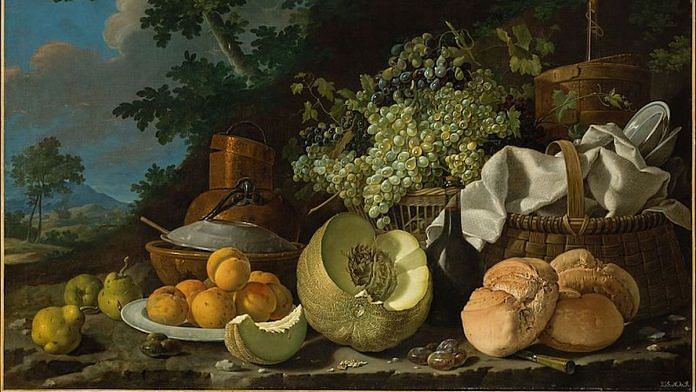The nation’s national wealth was indicated through meat consumption: Britain was the heaviest consumer of meat in Europe. Several private memoirs, diaries, and letters of British officers and memsahibs attest that the British in India thrived on an elaborate diet of meat during the period. The starling array of meat consumed at Anglo-Indian breakfasts alone included crumbed chops, brain cutlets, beef rissoles, devilled kidneys, whole spatchcocks, duck stews, Irish stews, mutton hashes, brawns of sheep’s heads, and trotters in addition to Indian meat dishes like jhal frazie, chicken malai, and beef hussainee.
The massive consumption of red meat at breakfast was merely an English custom transferred to a tropical climate, irrespective of its suitability. During the early decades of Company rule in India, as Elizabeth Collingham’s work has shown, such ostentatious and unhealthy dining habits ‘served well to underline the status of the Company grandee in India’. However, with the increasing racialization of the Raj after 1857, the body of the British official in India became an even more powerful signifier of ‘Britishness,’ and diet and dress became, accordingly, cultural sites on which a sense of bodily difference between the British and their Indian subjects was maintained. According to Collingham, the lavish consumption of food and drink by the British in India was reminiscent of the nabob and continued to construct the official’s body as an aristocratic body in the Indian context. Over time there might have been a refinement of the eating etiquette compared with the meat-eating excesses of the earlier period, elaborate meals continued to be the norm.
Some Europeans in India, however, advocated vegetarianism. Tristram Stuart discusses the European fascination with Hindu-Brahminical vegetarianism in the early years of the Company rule. According to Stuart, the most surprising to western travellers in India were the masses of ordinary people who lived on what Europe considered an exceptionally abstemious diet. Stuart closely examines a few European travellers in India—Thomas Tryon and John Evelyn, among others—to demonstrate how they drew from Hindu theology and enshrined Indian vegetarianism in the mainstream of intellectual debate. The revered Jesuit missionary Abbe Jean Antione Dubois composed a tract, Hindu Manners, Customs and Ceremonies, where he depicted ahimsa as a cowardly and effeminate doctrine, but sought to explain the real historical origin for vegetarianism through climatic compulsions.
Also read: Kali Puja cuisine has veg mutton, chopsuey, biryani, guilt and Gelusil
According to Dubois, meat was indigestible and putrid in a tropical climate His suggestion was endorsed by a widespread tradition of European tropical medicine like the work of British naval surgeon, James Johnson, who, in his The Influence of Tropical Climates, More Especially the Climate of India, on European Constitutions (1813), applied the principle of temperance very strictly. Having identified over-stimulation and a tendency to plethora as the greatest risk to the Europeans newly arrived in a tropical climate, he recommended a cooling vegetable diet. Johnson’s recommendations were based on the eighteenth-century view of a vegetable diet as an antiseptic regimen which cleansed the bodily fluids of impurities while meat, as a stimulant, induced plethora, especially if taken in large quantities. Collingham argues that the Brahminical prohibition of wine and meat, as well as the simple diet of rice and vegetables of the Hindu poor, appealed to the temperance-minded British physicians as a laudable Indian custom, which contributed greatly to the health of the Indian population. Thus, British physicians like Johnson held up the Brahmins as models of ascetic, suitable behaviour. Having said that however, Collingham notes that most Anglo-Indians took little heed of arguments in favour of the vegetable diet and many resisted medical attempts to Indianize their constitutions.
Thanks to the lavish consumption of meat by the British in India, stomach disorders were inevitably common, but everyone blamed the climate rather than the unsuitability of their diet. The Governor, Philip Francis, thus wrote in 1775, which attests to the over-indulgence in meat: ‘I am tormented with the bile and obliged to live on mutton chop and water. The Devil is in the climate I think.’ These ostentatious eating habits were, as Burton argues, deployed as the cultural markers of a masculine, physically superior British Raj. In a similar vein, John Beames wrote about their daily eating habits:
Our chota haziri, or little breakfast, was at five-thirty to six, and consisted of tea, eggs boiled or poached, toast and fruit. Breakfast at eleven consisted of fried or broiled fish, a dish or two of meat—generally fowl cutlets, hashes and stews, or cold meat and salad followed by curry and rice and dessert. We drank either bottled beer—the universal Bass— or claret. Between four and five there was tea and cakes. Dinner at half past seven or eight consisted of soup, and entree, roast fowls or ducks, occasionally mutton, and in cold weather once or twice beef, an entremet of game or a savoury, and sweets.
Also read: Faith, freedom, finance leave Gurugram divided over ‘unfair & unjust’ no-meat Tuesdays
If the gastronomic delights of the British were considered to be a metaphor for a physically superior Raj, the native kitchen was however very bleakly portrayed as symbolic of all that was filthy, dirty, and uncouth about Oriental cultures. The author of a cookbook described a typical kitchen in an Anglo-Indian compound as ‘a wretchedly mean, carelessly constructed, godown [outbuilding] … inconveniently far from the house, and consequently open to every passer-by.’
 This excerpt ‘Meat, Mercy, and Morality: Animals and Humanitarianism in Colonial Bengal, 1850–1920’ by Samiparna Samanta has been published with permission from Oxford University Press.
This excerpt ‘Meat, Mercy, and Morality: Animals and Humanitarianism in Colonial Bengal, 1850–1920’ by Samiparna Samanta has been published with permission from Oxford University Press.







Only these ultra legend can term food as Brahmanical without knowing that Brahmans also consume meat. As per Ved food should be consumed by Physical or Environmental need. In mountain if you are following vegetarianism blindly than your just a foolish.
hottest starts up in siliconn valley today are beyond meat, veg burgers etc. to fight climate change, improve health.
Unnecessary publication of this article in this hour.
What is the use of this useless article, why we need to know what and who ate what. People know what to to eat.
As for I understand vegetarian food is good and healthy to once thinking . It may be noted that brahmins are most wisest people in India and the seldom resort to violence . It is proven belief that food you eat will make you wise in your action which is good for the society as whole
It has become a fashion to point BRAHMINISM for whatever the Customs of Hindus. Today, many non brahmins have become fully Vegetarian. I directly pose a question to the Author of the Article. He is just stupid in writing this article. INDIA owe an Apology from BRITAIN. In fact the Queen should apologise . Can you write an Article on this issue ??
Absolutely facsinating. To see the lense which the aggressors viewed their prisoners, and themselves.
Consistent that’s for sure.
UK /Europe hardly ate much meat until they got the colonies. They seem to have eaten really savagely, if you read Dickens or Bill Bryce’s historical research: babies and children ate what fell on floors! Game meat had to rot for days before becoming edible. The club members ate dinner, smoked and used potties together: hence women stayed away from this area. Nobody bathed much until the Europeans saw the Indians and Chinese bathing regularly.
Please get away with your meat food ideologies. We are good with our food and habitat. We do not encourage any sort of Non vegetarian foods.
29 locally 23 official were hanged on kikar tree village confesticated villagers turned to servitude in my village , 34 killed under heavy stone rollers in neighbouring village by these moral ones in 1858.
Brahminical or otherwise… the hindu way of life… simple… vegetarian.. limited desire… minimal expression would gave been best for the world… could have avoided aggressive world wars… inhuman occupation and appropriation of entire civilizations by marauding tribes…forcible partitioning of settled societies and erstwhile countries…
Vegetarianism and non-vegetarianism is irrespective to any caste, race and/or community. I’m a Brahmin myself, but we do eat chicken, mutton and seafood. There’s a Pandit layer of the Brahmin caste who dedicatedly follow vegetarianism, bu again, that is their personal choice and wish to be so and they have all the right to. Yes, being a vegetarian or no, it’s very subjective. So, please do not attach any human barriers to eatables – veg or non-veg. ?
It is quite hilarious how vegetarianism is portrayed as “Hindu-Brahminical”, I have friends and relatives that are from reserved class but still have vegetarian diet. They say there ancestors didn’t consume meat. I couldn’t understand the caste-based dietary segregation presented over here.
Does any one care or give a rat’s ass what the British love??? How come we got a context now to find out? For what? Sheesh…….All I know is that the Tami Brahmin are stateless persons like the jews before the World war 2 but now in independent India.
The writer is high on weed
Or is a moron and clown by birth
There’s nothing brahminical about being vegetarian. It is purely a scientific thing. After paying much attention to our own body for different tasks different kind of meals were advised. Please do not add caste, which was a tool used by west to divide india on every topic about hindu culture.
There’s nothing brahminical about being vegetarian.
Wrong. Brhamins were the first to select vegetarianism as right way of living, with non-violence or Ahinsa as central idea. Jainism & Buddhism also accepted that idea. It is your third worldite inferiority complex that compel your not to give credit where it is due.
Of course there are some Brahmin groups like Pandits of Kashmir of Bengali Brahmins who eat meat. But in contrast in Gujarat most of Hindus are vegetarians. this is due to influence of Hinduism & Jainism.
Scientific thinking about meat eating or not eating in recent phenomenon. The spread of Vegetarianism & Veganism in west is not due to scientific thinking but due to ethical considerations, though science to a large extent backs that thinking.
From anatomy human body is not designed to be carnivore. We don’t have canine teeth like predators. So meat is acquired diet, not natural one. Brahmins were the first to moved away from eating meat. So they deserve credit.
Yes,Mr Srivastav is right. Please do not try to view or associate everything and anything in India with religion and caste. People are tired of Religion and caste issues.
“People are tired of Religion and caste issues.”
People are not tired of religion. It is secularists, who feel that rug is pulled out under them, are tired of religion.
Bhagat singh and others bodies being dismembered, hacked to pieces after hanging – is a less known fact about the atrocities committed by British Raj . This and the brutal public murder of Lala Lajpat Rai and the Jalian walah bag massacre stand out as Testimony of the Black deeds perpetrated officially by elected His Majesty’s government on Colonial subjects. The Racist Privy council and shamelessly arrogant House of lords should Apologise for their Abominable behavior instead of Uppity public demeanor Put forth publicly to this day. The English for all their ostentatious, proud public stance of Superiority should hang their heads in shame .
Still we Indians haven’t got over the hangover of British Raj.
We still yearn for the white skin & everything starting from education , clothes ,eateries& whatnot.The word British is synonmous with arrongance& brutality which we witnessed during the British era.
The whites don’t consider others as even human…. they dropped the atom bomb in Japan not Germany
‘ Hindu brahminical vegetarianism’. Myth making much. There are more non-Brahmin vegetarian castes and communities in India then ‘ brahminical’.